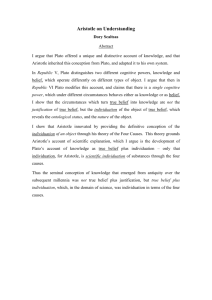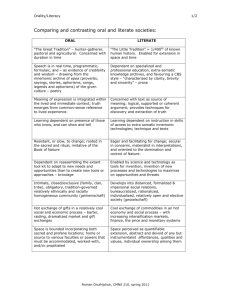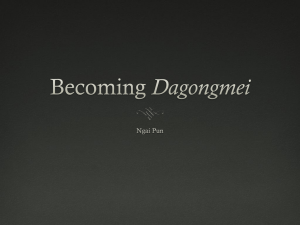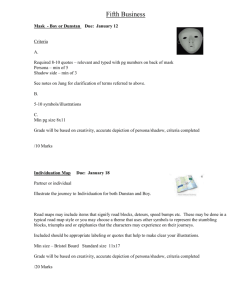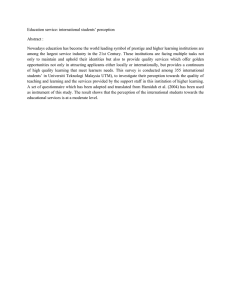Art out of step, art out of time: a Simondonian aesthetics
advertisement
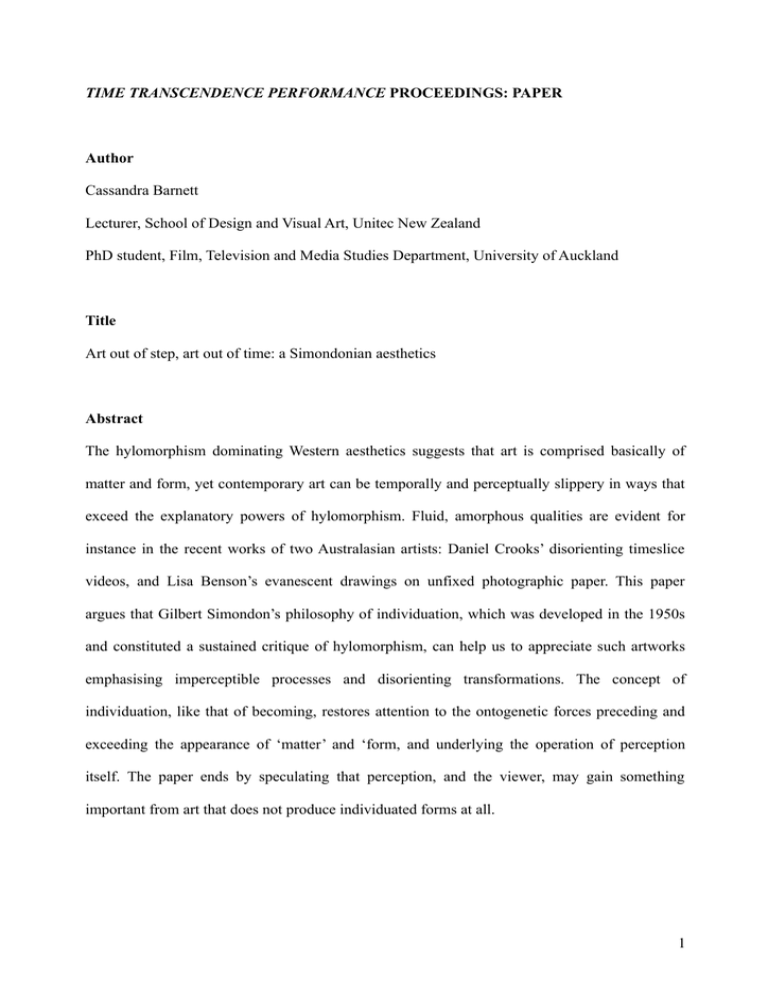
TIME TRANSCENDENCE PERFORMANCE PROCEEDINGS: PAPER Author Cassandra Barnett Lecturer, School of Design and Visual Art, Unitec New Zealand PhD student, Film, Television and Media Studies Department, University of Auckland Title Art out of step, art out of time: a Simondonian aesthetics Abstract The hylomorphism dominating Western aesthetics suggests that art is comprised basically of matter and form, yet contemporary art can be temporally and perceptually slippery in ways that exceed the explanatory powers of hylomorphism. Fluid, amorphous qualities are evident for instance in the recent works of two Australasian artists: Daniel Crooks’ disorienting timeslice videos, and Lisa Benson’s evanescent drawings on unfixed photographic paper. This paper argues that Gilbert Simondon’s philosophy of individuation, which was developed in the 1950s and constituted a sustained critique of hylomorphism, can help us to appreciate such artworks emphasising imperceptible processes and disorienting transformations. The concept of individuation, like that of becoming, restores attention to the ontogenetic forces preceding and exceeding the appearance of ‘matter’ and ‘form, and underlying the operation of perception itself. The paper ends by speculating that perception, and the viewer, may gain something important from art that does not produce individuated forms at all. 1 Keywords Gilbert Simondon, individuation, Lisa Benson, Daniel Crooks, aesthetics Paper Becoming exists as one of the dimensions of the being… it corresponds to a capacity beings possess of falling out of step with themselves, of resolving themselves by the very act of falling out of step. (Simondon 1992, 300) This paper tests the potential of Gilbert Simondon’s philosophy of individuation for aesthetics, via an engagement with single works by two current Australasian artists. Simondon was a student of Maurice Merleau-Ponty; his works on individuation and the philosophy of technology were written in the late 1950s, and these works were influential, in particular, upon the late twentieth-century philosopher Gilles Deleuze. Simondon’s works have more recently been revisited by philosophers Bernard Stiegler, Brian Massumi and Elizabeth Grosz to name just a few.1 I will first introduce the two artworks and describe some of the tensions they give rise to. I will then outline Simondon’s concept of individuation. Finally, I will bring the art and the individuation together, explaining why I think an art of individuation can offer something novel and important to perception, and something meaningful to the lives of its viewers. Pan No. 2 (One step forwards, one frame backwards) (2007) is a video work by the New Zealand-born, Australia-based artist Daniel Crooks. At one level, the work presents us with a fairly mundane urban scene: a cosmopolitan array of people (some besuited, some capped and skateboarded, some resplendent in designer logos), a variety of vehicles, roads and tramways and train tracks, and the odd pigeon. All these elements are bathed in the crisp, blue-skied 1 As further evidence of his growing relevance to contemporary thought, in 2009 a special issue of Parrhesia: A Journal of Critical Philosophy was devoted to the work of Simondon. 2 brightness typical of a hot day in Melbourne, and there is a continuity to the movement in the scene that is vaguely suggestive of real time, of a single-take slice of life. However, none of the elements I’ve mentioned are behaving as you would expect them to. Instead, their slow, fluid movements are inventing new relations between space and time and perception with each and every frame of the video projection. The people’s ambulations appear arbitrary, ludic, sometimes occurring on the spot, only occasionally actually propelling them through space. Even when the figures are displaced, they drift according to some remote locomotive power quite disconnected from the laws of physics. And at times they drift in several directions at once, thus also upsetting our temporal assumptions. For irrespective of whether they are moving or still in the extensive sense, the figures are continually subject to another, intensive movement, causing them to stretch then dwindle, implode then bloom forth in a perpetually renewed interrogation of their own shape, their internal organisation, their very existence. (The still-sequence in Figure 1 gives a rough idea of the work’s transformations, though of course to experience their full effect one would need to watch the video itself.) 3 Figure 1 Daniel Crooks Pan No.2 (one step forwards, one frame backwards), 2007 video still sequence digital video, 4:43 minutes, 16:9, stereo sound courtesy the artist & Anna Schwartz Gallery So instead of the distinct bodies and opposing forces of Newtonian motion, we seem to be witnessing a different dimension of melding bodies and unified forces. Subjects and objects of action are hard to define. Figure and ground are not always distinguishable. Events can’t be lined up chronologically. And since single-source perspective isn’t quite working, our own position as viewer is also destabilised. Witnessing this familiar-yet-unfamiliar scene, viewers may be forgiven for feeling similarly amorphous, for falling out of step with themselves. What is this space that will not be walked over? What is this time in which individuals may be doubled, 4 halved, multiplied, dispersed, co-existing with themselves and travelling in numerous directions at once? What is this flickering, floating world of extinctions and rebirths? I’ll come back to these questions. Another artist whose works pose temporal and perceptual paradoxes is New Zealander Lisa Benson. Compared with Crooks, Benson’s tools are rudimentary and her results are often fugitive and lo-fi, but the parallels between their work offer an interesting seam for investigation. 5 Figures 2-4 Lisa Benson Fade, 2008 Work featured in group exhibition atmos, MIC Gallery, Auckland, 2008 Antique black and white photographic paper and gathered light from the artists studio and MIC Gallery for the duration of atmos courtesy of the artist and Antoinette Godkin Gallery 6 Benson’s work Fade (2009) was installed at the Dancehouse Gallery in Melbourne for the duration of the Time Transcendence Performance conference. (An earlier incarnation of the work was shown in 2008 as part of atmos, a group exhibition at MIC Gallery in Auckland; the installation shots printed here as Figure 2, 3 and 4 are taken from that show.) Fade consists of a series of rectangular ‘drawings’, as Benson calls them, of various sizes, scattered across a wall of the gallery – a wall adjacent, at one end, to a vertical sliver of window. The initial impression is of a candy-coloured sprawl of restrained geometric abstractions. But if you take a closer look, it is pretty clear from the velvety sheen of the emulsion and the curling edges that these drawings are in fact images made with light on traditional photographic paper. The idea of photographic abstractions may pose a mild conundrum for old-school art historians, but the more interesting paradox is one that takes a while to dawn. To see it, you need to stick around for a while, or make repeat visits to the gallery. For, in fact, the works are unfixed and still gathering light, and hence quietly, slowly expiring before your eyes. The process may speed up or slow down depending on the quality of light on a given day, but either way it is gradual enough to only be detectable after a period of time has elapsed. Having discovered this fact about the works, viewers often start to ‘look for’ the change, wanting to bear witness to it, to ‘see’ the art for once and for all. Some viewers (especially the buying kind) even want to prevent the change by fixing the images and preserving their fragile beauty. Yet we can’t prevent it and we can’t see it – at least not without looking away for a time and back again. In a sense, to see it, we must miss it. If sensitive to such things we may find ourselves moved, for the work is subtly lifelike: moving, changing, dying, eluding our grasp. Whatever we see is instantly gone forever, we have no time to get acquainted with the work in 7 its current form, our thought can’t keep up with what we’re seeing. One way or another, Benson’s work, like Crooks’s, throws us out of time, out of step with ourselves. I will now turn to Simondon’s theory of individuation. For those unfamiliar with the concept, it bears some relation to the notions of ‘becoming’ and ‘emergence’. Simondon theorised individuation in a number of texts devoted to different levels of reality, from technological invention to human psychic individuation. As Elizabeth Grosz points out: “Individuation is in no sense tied to the human: it is what characterises cloud formations, the formation of crystals, the currents of oceans, as well as the development of cells, and the creation of individuals” (Grosz 1998, 38-55). For ease of explanation I am in this paper focusing on Simondon’s account of the individuation of a brick, one of his more concrete objects of investigation. This account opens Part I of his 1958 thesis, published as The Individual and its Physico-Biological Genesis (1964). I will then introduce a few concepts from Part II, published as Psychic and Collective Individuation (1989), in which Simondon analyses the individuation of the living. 2 In theorising individuation, Simondon wished to challenge our abiding tendency to think in terms of discrete, fully-constituted, separate entities or individuals, be they bricks or humans, as though they are simply given. For instance, where the brick is concerned, we might describe its production hylomorphically, in terms of some matter (clay) being given some geometric form (a cubic rectangle) via a mould. But matter and form, clay and rectangular mould, are all discrete individuals, so we still would not have explained the dynamic process whereby these individual 2 The majority of Simondon’s work has not yet been translated into English; hence I rely on unpublished translations for my quotations in this article. I would like to acknowledge the generosity of Taylor Adkins in providing these. 8 units came together to generate something new. To really understand how a brick takes form, says Simondon, “one would need to penetrate inside the mould itself to follow the operation of the capture of form to the various levels of the dimensions of physical reality” (Simondon 2007a, 8). And this is what Simondon does for us: he takes us ‘inside the mould’ to follow the ‘operation of the capture of form’. During this operation, he explains, clay is pressed into a mould by the energy of a worker, the malleable clay becoming a vehicle for that energy. Meanwhile the mould opposes the energy carried in the clay with its own weaker force, limiting where the clay can go. Individuation occurs when the energetic potentials of disparate elements (clay, mould) are brought together and actualised in this way. They create a metastable state of tension that, for the duration of the operation, is unified as a single system, a reciprocity of forces. “So that there is a single system of forces”, says Simondon, “it is necessary that matter and form both play a dynamic role; but this dynamic equality is only true in that moment” (Simondon 2007a, 5). The individual brick that results is the unpredictable product, the once-only actualisation of this dynamic energy system, mediating between the clay and the mould and the worker. But that’s not all. For this highly charged and instantaneous clay+mould+energy system to become possible, whole series of prior energy transfers and physical transformations were needed: To give a form, it is necessary to construct such a defined mould, prepared in such a fashion, with such a species of material. There thus exists a first advance which goes from the geometrical form to the concrete material mould […]. As for clay, it is also subjected to a preparation; as a raw material, it is what the 9 shovel raises to the surface at the edge of the marsh, with roots of rush, and gravel grains. Dried, crushed, sifted, shaped, lengthily kneaded, it becomes this homogeneous and consistent dough having a rather great plasticity to be able to embrace the contours of the mould in which one presses it, and firm enough to preserve this contour during the time necessary for that plasticity to disappear. (Simondon 2007a, 2) Once we start thinking in terms of these long chains of physical transformations and transfers of potential forces, we start to understand how separate individuals like rectangles or moulds or marsh clay or brick-making dough are in fact the ‘by-products’ of imperceptible processes of energetic mediation; of individuation. During such processes, great temporal distances are collapsed. The time of the worker and the time of the marsh and the time of the thought of a rectangle attain a shared time, in which past and future intermingle. The extraction of clay from the marsh contained a premonition of the brick-making operation; the brick-making operation now activates some of the potentials in the marsh. Individuation is this simultaneous discovery of both a problematic (great physical or temporal incompatibilities) and a solution to that problematic (a common order, of forces and potentials, where incompatibilities may be resolved). Simondon wants us to see the ‘more-than-this’ that is individuation: the hidden aptitudes of clay and mould; the potential they contain to connect, to communicate, to processually resonate with each other. For Simondon, this communication is the real individuation, and “the form that we see is only the vestige of the individuation that was formerly achieved in a metastable state” (Simondon 2007b, 4). 10 Moreover, those forms, the products of individuation, are not only individuals. For, like each transmutation of the marsh clay, they continue to carry forward within them potential forces that may become joined to other forces to produce other individuations. The brick may join with cement and bricklayer and other bricks to compose and sustain a tower; or it may come together with an arm to break a window. I will now go over the individuation of the living, which Simondon explains in Psychic and Collective Individuation partly in terms of the operation of perception: the perception ‘by’ subjects ‘of’ forms or objects. Clearly, though Simondon doesn’t discuss it, this relates to the viewer and the work of art. Considered as individuals, subject and object, or viewer and artwork, are as disparate, heterogeneous and incompatible as clay and rectangle. Perception is the individuating operation that brings these elements together. Perception, like the brick, results from a metastable state of tension between heterogeneous elements. But in the case of the living, the tension or incompatibility exists between a subject and the milieu it finds itself in. The operation of perception discovers, within that state of tension, within the energetic potentials carried by a subject and a milieu, an internal resonance, a compatibility between them. This compatibility manifests as the form of an individual object now perceived by an individual subject. Simondon writes: Perception is not the grasping of a form, but the solution of a conflict, the discovery of a compatibility, the invention of a form. This form that constitutes perception not only modifies the relation of object and subject, but also the structure of the object and that of the subject. (Simondon 2007b, 3) 11 The degree of intensity of the tension or metastable state underlying the perception influences the kind of subject and object produced by the perception. Simondon gives the example of a child’s aptitude for recognising parts of the body when encountering a specific animal for the very first time: [In this] situation strongly developed by fear, sympathy, or terror […it is] the tension, the degree of metastability of the system formed by the child and animal in a determined situation, which is structured in the perception of the corporeal diagram of the animal. Here perception not only grasps the form of the object, but its orientation as a whole, its polarity which makes it lie down or draw up on its legs, makes it fight or flee, or makes it adopt a hostile or a trustful attitude […] (Simondon 2007b, 4) So, what the child experiences is part of what the child then perceives: not just an animal shape but its orientation, as well as the child’s relative orientation, in a dynamic relationship. The greater the dynamic intensity between subject and milieu, the more ‘pregnant’ the resulting objective perception. For in the act of perception, not only is the form of an object discovered; its orientation or polarity is too. And simultaneously, in this moment of perception, the subject is also oriented. The subject perceives, Simondon says, so as to be oriented, and each form or object perceived is in fact an intermediary, enabling a coupling of the subject and the world. The act of perception is this reorganisation of a structure or relationship, incorporating subject and object and world. Simondon clarifies, “it is not the object that is perceived, but the world, polarized in a way such that the situation has meaning” (Simondon 2007b, 9). 12 So how might these ideas of Simondon’s help us when viewing the two artworks I showed earlier? I’ll start with Lisa Benson. Like Simondon, Benson directs the viewer’s attention towards the whole process of individuation, which is in excess of the individual units produced. The real work of art Fade is not the drawings/photographs/images, but the whole operation of the capture of form: the mediation between the photographic paper’s potential and the light’s force, occurring on a dimension where paper and light, despite their heterogeneity, engage in a singular, reciprocal communication. Benson reminds us that the forms we see (colour, tone, two-dimensional shapes) are merely a vestige of that encounter, that meeting of forces; and that these forms are already feeding into new individuations, new forms. Like the prepared, malleable clay, the art you see now contains inexhausted potentials carried over from past transformations; in the work’s seeming ‘aliveness’, its metastability, we sense the level of indeterminacy whereby any visitor to the gallery could yet lay a hand on one of these images and irrevocably alter its evolution. At the same time, the artwork’s potential is delimited by its current form. Here, darker marks framing the edge of the paper index its earlier position in a stack whose sides alone were susceptible to the light. There, cloudy forms record the presence of mould on the aged paper (see Figure 4). These individuations cannot be undone. The imperceptible swelling of future possibilities is a part of the work now; the forms perceived today contain in some part the work’s future. At the level of force these temporal distances can be bridged. Whenever you see the work it reveals the potential for forms to appear, and disappear. In a moment I will attend to the effect of all this on the viewer, but first I would like to return to where I started, to my questions regarding Daniel Crooks and his world of disorienting movements, spaces and times. What is this world Crooks has created? Perhaps it is a world of individuation. I think that Crooks, like Benson, alerts us to the whole process of individuation, 13 and not just its products. But with Benson we ‘see’ what we can’t see – the invisible dimension of potential – when we look away from the work’s present form. Crooks, instead, performs a sleight of hand that makes the invisible presently visible. If spatially and temporally disparate elements attain a common dimension during individuation, Crooks literally pictures this for us. Consider his technical procedure. To make these works, Crooks takes the digital frames of his video-recording, ‘slices’ them up vertically, then rearranges these thin strips so that segments from earlier and later frames now sit alongside each other in a single frame. Through this rearrangement, disparate fragments of a figure’s successive movements through space and time are given simultaneously so that, when animated, the figure appears to us to have multiple polarities; to be moving in several directions all at once. Magicked away is the linear time of individuals, individuals which are now here and now there but never in both places at once. In its place is a diagram of the time of individuation. Thus, in Pan No. 2, we see how a figure’s movement enacts, moment by moment, new syntheses of its past and future potentials. What for Simondon occurs on the level of force is, thanks to Crooks, suddenly perceptible at the level of not-so-individual bodies. Instead of individuals, we see a rising and falling of tensions and resolutions, we see the capacity to individuate. Finally, I would like to consider the individuation undergone by the viewer of these works of art. Both Benson and Crooks draw our attention to something we don’t ordinarily see: the realm of potential, the communication between heterogeneous forces that makes our perception of individual forms and objects possible. They offer us a kind of perception-plus, a perception that ‘sees’ more than this, that ‘sees’ the process of individuation. But if we need the perception of forms to be oriented in the world, as Simondon suggests, what happens to our orientation when we ‘see’ more 14 than this, when we see perception itself in its process of emergence or individuation? And what kind of orientation, what kind of coupling between viewer and world, will result from this kind of seeing? Simondon writes: “Every time the tension of the system cannot be resolved in the structure or the organisation of the polarity of the subject and the polarity of the object, a malaise remains” (Simondon 2007b, 4). I think that both Benson and Crooks alight on this malaise, only in their hands it becomes no longer a malaise but an opportunity. To couple with the worlds they offer, to find an orientation, the viewer must, in a sense, start perceiving differently. The only perceptible forms an encounter with this art can produce are dynamic forms, forms on their way to becoming new forms. Thus every orientation is swiftly undone. That is, the only orientation the viewer can find is one of perpetual disorientation. The relationship with the world encouraged, demanded, by these works is one in which transformation and disorientation become the solution to the tension of the system, indeed, they become the only workable mode of coupling with the world. Such a solution is possible because we viewers already carry within us, at the level of potential, a wealth of dynamic and disorientating forces – forces retained from our own past individuations (most likely occurring outside of the gallery) and waiting to be called upon when new incompatibilities arise between us and our world. What is individuated again and again during this kind of perception is a new structure for the artwork, a new structure for the viewer, and a new polarity for the world they share; a polarity which produces transformation and disorientation as meaningful forms. Meaningful because when we look at Crooks’s videos, we see the way we too are coming into being continuously. In Crooks’s blooming, smearing, recomposing forms – as in the unstoppable 15 emergence and decay of Benson’s drawings made with light and time – we see something of what it really feels like to be alive, falling in and out of step, losing ourselves and reinventing ourselves and losing ourselves again from moment to moment to moment. Works Cited Grosz, Elizabeth. 1998. Thinking the New: Of Futures Yet Unthought. Symploke 6, no. 1: 38-55. Simondon, Gilbert. 1992. The Genesis of the Individual. In Incorporations, ed. Jonathan Crary and Sanford Kwinter, trans. Mark Cohen and Sanford Kwinter, 296-319. New York: Zone. ---. 2007a. The Individual and its Physico-Biological Genesis. Trans. Taylor Adkins. Unpublished translation. ---. 2007b. Psychic and Collective Individuation. Trans. Taylor Adkins. Unpublished translation. Images High-resolution images have been provided separately due to their large file sizes. Image Captions Figure 1 Daniel Crooks, Pan No.2 (one step forwards, one frame backwards), 2007, video still sequence, digital video, 4:43 minutes, 16:9, stereo sound, courtesy the artist & Anna Schwartz Gallery. Figure 2 – Figure 4 Lisa Benson, FADE, 2009, installation shot, antique black and white photographic paper and gathered light from the artist’s studio in Hamilton, New Zealand (2003-2009) and the Dancehouse Gallery, Melbourne (for the duration of Time Transcendence Performance), courtesy the artist. 16 17


